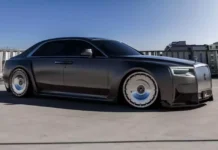Earles Fork
The Earles Fork – named after its inventor – is an example of the diversity of front suspension using leading link (girder fork is also a type of leading link). This type of fork was invented in 1953 by a British man named Ernest Earles, with a telescopic fork – girder fork – attached near the axle of the front wheel. Unlike conventional telescopic forks, the Earles Fork is safer when braking or encountering obstacles. This fork is more stable than telescopic forks, especially when making sharp turns or when turning with a sidecar.
.jpg) Design of the Earles Fork.
Design of the Earles Fork.
When braking, the fork frame forms an isosceles triangle, and all forces are directed towards the fork and downwards to the ground – this cannot be achieved with telescopic forks – creating high safety for the rider.
.jpg) Original design of the Earles Fork and a customized fork.
Original design of the Earles Fork and a customized fork.
Many motorcycle manufacturers applied this type of fork to their racing models in 1953 such as MV Agusta and BMW. In addition, this design was also used by many motorcycle manufacturers on specialized road or off-road models such as the Douglas motorcycle. From 1955 to 1969, BMW exclusively used this type of fork on its models.
.jpg) Earles Fork design on a BMW.
Earles Fork design on a BMW.
However, despite its advantages, this fork also has the disadvantage of reducing the front-wheel grip, so it is gradually being used less.
.jpg) BMW R50 using Earles Fork.
BMW R50 using Earles Fork.
Girder Fork
One of the first types of forks for motorcycles is called the girder fork, which consists of a pair of straight axles connected by a pivot that can rotate, with a spring placed on the central axle of the girder.
.jpg)
.jpg) Operation mechanism of the Girder Fork and used on Chopper custom bikes.
Operation mechanism of the Girder Fork and used on Chopper custom bikes.
When there is an impact, the force will be directed to the two front legs, pushing these legs upwards and compressing the spring on the central axle to reduce the impact of the collision force.
Telelever Fork
This type of fork is originally called Saxon-Motodd but BMW affectionately calls it Telelever. It has a separate swingarm attached to the motorcycle frame and a suspension system placed on this swingarm that minimizes the shock to the rider.
.jpg) Telelever Fork design.
Telelever Fork design.
According to the Telelever design, since the swingarm is centered with the handlebars, when encountering bumps or braking, the spring on the swingarm is compressed, causing the wheelbase of the motorcycle to lengthen, making the motorcycle tend to “dive” forward (without the need for sudden braking), minimizing the phenomenon of wheel sliding. This is the main advantage of this design. However, the downside of this type of fork is that when the spring rebounds after being compressed (rebounds), all the force is exerted on the motorcycle frame instead of just the handlebars, so even though it provides a comfortable ride, it still lacks the “feeling” or in another way, “floatiness.”
.jpg) BMW R1200GS – a model using Telelever Fork.
BMW R1200GS – a model using Telelever Fork.
Duolever Fork (Hossack/Fior)
After the single-armed version, BMW cast a spell and introduced an improved version called Duolever based on the Telelever older brother. This design was developed by Norman Hossack and used by Claude Fior, John Britten on their racing models. In 2004, BMW officially introduced the K1200S model with a new fork called Duolever. Following that success, BMW launched the K1200S, K1200R, and K1200GT models, all of which use Duolever.
.jpg) BMW K1300R using Duolever Fork.
BMW K1300R using Duolever Fork.
The design of this type of fork is completely different from the Telelever. The shock absorber is attached to the front forks by two swingarms, and between these swingarms, there is a hinge that connects the front forks to the motorcycle frame vertically, so Hossack called this a “steered upright” mechanism.
With Duolever, when making turns, the wheelbase and the inclination of the fork almost do not change, creating a very stable feeling for the rider.
- Understanding the structure of motorcycle front suspensions (Part 1)
- Understanding the structure of motorcycle front suspensions (Part 2)
Thanh Phan (Trithucthoidai)









































![[Quick Review] Ford Territory: A Powerful Competitor to Tucson, Corolla Cross](https://vnauto.net/wp-content/uploads/2023/11/xehay-fordterritory-10102022-3-100x70.jpg)